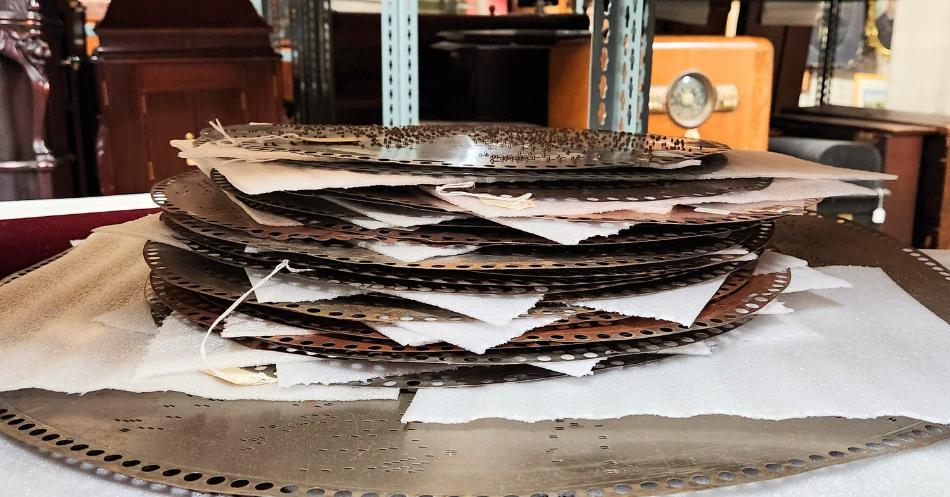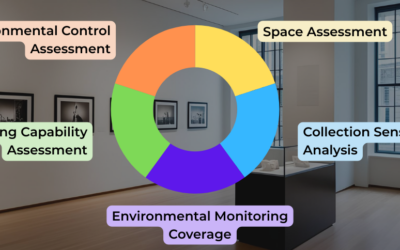By: Jace Dostal, Curator of Collections, Arizona History Museum
Collections at the Arizona Historical Society
Established by an Act of the First Territorial Legislature on November 7, 1864 (almost 50 years prior to Arizona becoming a state), the Arizona Historical Society (AHS) is Arizona’s oldest historical agency. In the over 150 years of AHS’ existence our historical collections have grown to surpass 60,000 objects, split unevenly between four regional museums. The Arizona History Museum in Tucson, our oldest museum, houses between 25,000-30,000 of these objects with a focus on Southern Arizona History from the first Spanish contact with the Native tribes through Arizona Statehood and the mid-20th century.
As with many museums, the Arizona Historical Society’s collection growth has far outpaced the growth of our storage space. Over the decades, AHS staff have done their best to find and create a safe storage environment for our collections, but as funding dried up it became increasingly difficult to find feasible solutions for our storage issues. For various reasons, certain collections were prioritized while others went untouched for 20 years. One such collection housed in Tucson is a set of Regina Music Box discs, Edison Disc Records, and Organette music rolls all dating to the turn of the 20th century.
These objects had been dangerously stacked on top of each other, with many of the music box discs already beginning to warp due to the weight and pressure of the stacks.

Regina Music Box Discs at the Arizona History Museum in Tucson stacked on top of each other before the rehousing project. Image courtesy of the Arizona Historical Society.
When I first started at the Arizona Historical Society, two years ago, I was focused on catching up on the years of catalog backlog that had accrued and finding locations for objects that were not currently in our storage rooms. Because of this there was no time to work on rehousing projects that needed to be done. However, throughout this time I kept coming back to the stack of music discs that were sitting on our shelves.

Organette music rolls at the Arizona History Museum in Tucson in boxes before the rehousing project. Image courtesy of the Arizona Historical Society.
Clearly this was an improper way to store them, but at the time there really wasn’t a better option available. With no funds to purchase the preservation supplies needed to properly house this collection the stacks remained.
An opportunity for better storage solutions
When information about the Conserv Preventive Conservation Award was shared with me I knew the time had finally come to do something about the stack of music discs and rolls. At this point, I had already conceptualized a few designs for custom boxes that could be created to rehouse the collection.
The plan was to use sheets of archival e-flute corrugated board and Ethafoam® to create custom sized boxes with individual slots for each disc and roll to rest in. This would not only alleviate the pressure placed on the objects from being stacked and hopefully prevent further warping, but also make it easier to find each individual object now that they would have a more specific location.
This award helped turn my concepts into reality.
Supplies purchased for the project from Gaylord Archival were:
- 40 x 60” sheets of E-Flute Corrugated Board
- 12W x 24X 1”D planks of Ethafoam®
- Scoring wheels
- Polypropylene Label Holders
Other supplies used:
- Thermogrip Hot-Melt Adhesive
- Hot knife foam cutter
- T-square
- Box Cutters
Experimenting with different types of supports for 3D objects
The project started off on a slow note with our order of e-flute being placed on backorder. This lull in activity gave collection staff time to finalize the design plans and to experiment with the Ethafoam® supports we wanted to create. At the crux of the issue was finding a way to store the discs and rolls upright and prevent them from falling over while carrying the box.
We began our experimentation with supports for the organette rolls. Our original idea was to place small chunks of Ethafoam® around the base of each roll, but we quickly discovered that this design did not provide nearly enough support for the rolls. Any small bump to the supports would cause the organette rolls to wobble precariously. Back to the drawing board we went.

Experimentation with Ethafoam® to support the organette rolls. Image courtesy of the Arizona Historical Society.
Our next attempt proved to be more fruitful. Instead of using small chunks of Ethafoam®, this time we chose to use an entire plank of foam with a divot carved into it for the rolls to rest in. This new design provided much more support for the rolls while they were resting on a table. However, we would shortly learn that this would still not be enough support.
Around this time, we received our backordered corrugated board. After using the board to build the first of our boxes, we glued the prepared Ethafoam® planks onto the base and placed the organette rolls into their slots. After each roll was in place it was time to test the stability of the rolls while the box was being carried. While the rolls were stable in the box with it resting on the table, as soon as we picked it up we realized that the base supports were still not enough to prevent the rolls from toppling over while the boxes were being transported. To remedy this, we created a top cap for the rolls that is pressure fitted into the box. The cap helps stabilize the rolls but is removable to provide easy access to the rolls inside.

Ethafoam® supports over corrugated cardboard to support the organette rolls in a vertical position. These are covered by a top cap with indented spaces to keep the rolls in place. Image courtesy of the Arizona Historical Society.
After we finished with the organette rolls we moved on to the Edison Records and music box discs. Again, the idea was to create a way for the discs to be stored upright in a box rather than stacked. To do this we took two blocks of Ethafoam® and carved multiple vertical notches into the foam, creating slots for the discs to slide into. We then glued the foam blocks on the inside wall of the box opposite each other.

Ethafoam® blocks with notches allow the music discs to slot in vertically into their new boxes. Image courtesy of the Arizona Historical Society.
With the Ethafoam® in place we were able to slide the discs into the boxes creating a much more organized storage system than what had previously been in place. This system seems to work better for the Edison Records than the music box discs. The pins on the music box discs tend to get caught on the foam when put in or taken out of the slot. Because of how thin and wobbly the discs are they also tend to slide into the wrong slot. Both of these issues can probably be solved by making the slots wider and further apart, ultimately resulting in less discs fitting in the box but providing a safer storage solution overall.
Future plans for the musical collection at the Arizona Historical Society
The results of this project have been immediately felt. Our collection is noticeably more organized and the pressure placed on the objects have been alleviated. There are already plans in place to expand this project to the rest of our musical collection. A big thank you to Conserv for making this all possible.

New storage solutions for the Regina Music Box discs, Edison Disc Records, and Organette music rolls after the rehousing project. Image courtesy of the Arizona Historical Society.
If you have any questions about environmental monitoring, integrated pest management, or just want to talk about preventative conservation, please reach out to us! Don’t forget to check out our blog or join our community of collections care professionals where you can discuss hot topics, connect with your peers or even take a course to get familiar with the Conserv platform.




